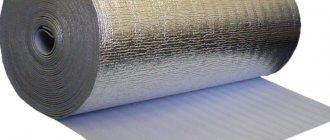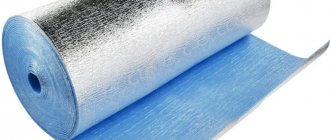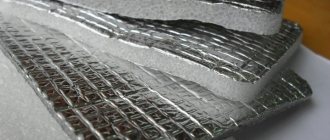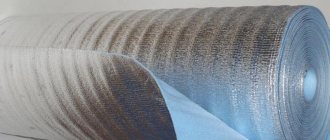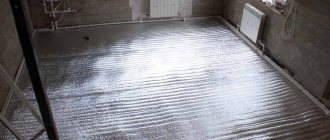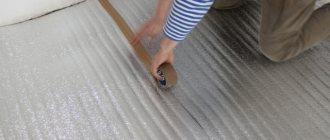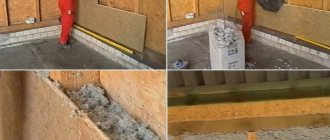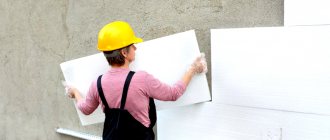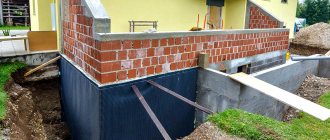Not everywhere you need thick mineral wool mats or rigid basalt slabs or panels made of extruded polystyrene foam for thermal insulation. Of course, such materials provide a great protective effect, but they can be difficult or even impossible to install in a given case. If you make the insulation thinner, it will not retain heat with the same efficiency.
The Russian “Information Technology Plant “LIT”” has found a solution to this problem. A thin layer of polyethylene foam covered with one- or two-sided foil coating reflects that part of the heat that it cannot retain due to its small thickness.
This is how we came up with the Penofol thermal insulation, which is widely used in construction and in the installation of pipelines and ventilation equipment. JSC "LIT" also produces hydro- and vapor barrier "Armofol", self-adhesive aluminum tapes "LAS" and insulated air ducts.
Using self-adhesive foil Penofol, builders solve several problems at once: insulation of a building or equipment, vapor and waterproofing, as well as fastening these materials, which often requires the application of an adhesive solution. Such insulation does not take up much space - from 2 to 10 mm in thickness.
Sometimes it becomes necessary to apply it in several layers. The material muffles noise from operating ventilation units, coolant movement or pumping equipment, which is why such systems are often insulated with this foil insulation. This makes it possible to lay communications in the ground or outside buildings. To maintain the temperature of heated water in boilers or other containers, it would be correct to insulate the outside of such equipment with foil material, which will create an effect similar to a thermos, returning heat back into the container.
Rolled insulation of this type is suitable for installation under rolled roofing materials of pitched roofs, facade cladding made of corrugated sheets or siding, to protect coolant pipes from moisture and energy loss. You can insulate the floor with reflective insulation by directly laying the rolls under the carpet, because they are not afraid of mechanical loads or possible moisture ingress. The material is also used to enhance the effect of basalt slabs or other insulation, as well as to protect it from moisture and condensation of water vapor.
There are several types of reflective thermal insulation of this brand based on design features. "Penofol-A" has a foil film on one side; “Penofol-” - on both sides, type “C” is foiled on one side and has a self-adhesive surface on the other. These features make it possible to choose the material that is most suitable in a particular case. The joints can be placed one on top of the other or sealed with a special self-adhesive aluminum film, which prevents the passage of steam or cold air. If you only need to organize thermal insulation, but leave the opportunity for water vapor to pass through it, then you need to use perforated Penofol. It reflects slightly less heat due to the small holes in the foil.
It is difficult to compare this material with other types of insulation, since it is completely different from them both in function and installation capabilities. Penofol is often used where no other type of thermal insulation can cope or will not fit properly.
Of all the insulation materials existing today, it is penofol and not foamed polyethylene that has the optimal ratio of price and thermal insulation characteristics.
What is penofol
The material belongs to a new generation of ultra-thin polymer insulation, manufactured using foaming technology. In this case, we are dealing with polyethylene foam welded to a layer of reflective aluminum foil.
Thanks to the manufacturing technology, the small pores inside the penofol have a closed structure, which is why the insulation practically does not allow water vapor to pass through. According to the manufacturers, the foil layer is designed to reflect the flow of infrared heat coming from inside the premises.
There are 3 main types of penofol:
- with one layer of heat-reflecting foil (type A);
- the foil is welded to the insulation on both sides (type B);
- on one side of the material there is foil, on the other there is an adhesive layer (type C).
Note. One of the latest innovations is single-sided (type A) perforated penofol. Many tiny holes are made in the insulation to make it vapor permeable.
The scope of application of penofol is thermal insulation from the inside of houses and apartments, including balconies and loggias, as well as any industrial premises. The insulation is offered in thicknesses of 3, 4, 5, 8 and 10 mm. To finally understand all the properties of the material, we suggest that you familiarize yourself with its technical characteristics presented in the table:
Areas of use
Penofol is often used as packaging material for industrial products for civil and military purposes. It is used in the production of printing products, advertising materials, refrigeration chambers and refrigerators, railway cars, and in the oil and gas industries.
In everyday life, self-adhesive foil penofol is used for:
- waterproofing basements, attics, roofs, attics, basements;
- insulation of communications (water, heating, sewer pipes);
- heat, noise and vapor barrier of residential premises (balconies, loggias, floors, ceilings in rooms);
- thermal insulation equipment for engines and car interiors;
- sound insulation of walls, floors, interior partitions;
- sealing door panels, window frames.
Penofol sections can be placed in residential areas behind heating radiators. The material will direct heat into the room and prevent its loss.
How to insulate with penofol
It should be noted that insulating anything (a wall, ceiling or roof) with penofol is really quite simple. If you follow the manufacturer's instructions, then to achieve maximum efficiency it is necessary to provide an air gap of 1.5 to 2 cm wide on both sides. To create such a gap, rolled penofol will have to be attached to wooden sheathing strips attached to the base.
That is, first you need to take 20 mm thick planks and attach them to the wall vertically or horizontally at intervals equal to the width of the penofol roll. If the house is wooden, then the planks are fastened with self-tapping screws; for brick or concrete bases, dowels will be required. Then strips of the required length are cut from the roll and attached to the planks with staples from a construction stapler.
Important. Unlike various thin films, the installation of penofol sheets is carried out not overlapping, but end-to-end. In this case, the foil side should be facing inside the room, and the joints should be carefully taped with aluminum tape.
When the layer of thermal insulation made of penofol is fixed and taped, the same strips are installed on top of it with your own hands to provide an external air gap. They are attached with self-tapping screws to the previous sheathing, and the outside is lined with plasterboard sheets or other finishing methods are used. Please note that a vapor barrier film is not laid, since there is no need for it; penofol itself is a vapor barrier.
It must be said that in practice, few people follow the instructions; usually penofol is attached directly to the wall or ceiling, and the air gap is made only on one side. This reduces the thermal insulation properties of the material, and further we will tell you why. When thermally insulating roofs or inclined walls of attics, installation of penofol is carried out by attaching it to the lower planes of the rafter boards. This means that the space between the rafters is filled with other insulation, since thin polyethylene alone will not be enough.
Important. If penofol can replace a vapor barrier, then under no circumstances can it replace waterproofing. You cannot lay it in the under-roof space in front of mineral wool; a diffusion membrane is needed there. It does not allow water to pass through, but also does not prevent the passage of vapors escaping from the cotton wool.
Floors in wooden houses are also insulated with foamed polyethylene, laid between the joists. Again, waterproofing is laid first, then slab insulation, and penofol on top. Putting it at the very bottom or in the screed is pointless; compression causes the material to cease to be heat-insulating. Although in practice such errors can be encountered often.
Another area of application of penofol is the insulation of balconies and loggias, where the material is laid as a second layer after more serious insulation materials - extruded polystyrene foam or polystyrene foam. The installation method is still the same: first, the sheathing bars are placed, polystyrene slabs are laid between them, and polyethylene foam is attached on top. After this, interior finishing is carried out.
Note. Perforated penofol is used as insulation for the walls of a wooden house in cases where it is necessary to ensure vapor permeability of the structure.
Insulation in a wooden house
Let's consider two methods of insulating the floor with penofol in a wooden house.
First we present method 1:
- The outdated floor is removed down to the concrete and debris is removed.
- The base is supported by logs with a small distance from the walls.
- After leveling them, the bars are mounted onto which the rough flooring is attached.
- 1 layer of penofol is laid down, which also serves as protection for the main insulating material located at the top. Stone wool is often used for this.
- Penofol is again laid out on top, with a 10 cm overlap. It is secured with a stapler, and the joining points are glued with foil-based tape. In both coatings, the mirror layer must be turned in the opposite direction.
- Control lathing is being carried out. Then the flooring made of chipboard and plywood is attached.
- The final floor covering is created on top.
Here are 2 ways to create foam insulation, which is used during repairs:
- The wood covering is freed from debris, and damaged boards are also replaced.
- Next, penofol is laid, with the glue side down and the foil layer on top.
- A control sheathing is being installed to form a ventilation passage.
- Chipboard is laid, onto which the final covering, such as linoleum or laminated plank, is then attached.
Benefits of penofol - debunking myths
Manufacturers and sellers of penofol attribute wonderful thermal insulation characteristics to this insulation, which is actually a myth.
Also, installation diagrams with air gaps, one of which we described at the beginning of the previous section, can be considered misleading the buyer. How the manufacturer proposes to insulate floors and roofs is shown in the figures:
In fact, the presented schemes are nothing more than another way to improve the thermal insulation of external fences using air gaps, since penofol’s own resistance to heat transfer is absolutely not enough.
This can be easily checked by taking as a basis the best thermal conductivity indicator from the technical characteristics table - 0.037 W/m2 °C. Next, we take the canonical formula and determine the thermal resistance of a material 4 mm thick:
R = δ / λ, where:
- δ – penofol thickness in meters, taken 0.004 m;
- λ is its thermal conductivity coefficient, equal to 0.037 W/m2 °C.
We get R = 0.004 / 0.037 = 0.11 m2 °C/W. Now look at the comparison table, which is presented on the same resource as the technical data. It says that 4 mm of penofol can easily replace 77 mm thick mineral wool or 46 mm thick polystyrene foam.
This means that, for comparison, it is necessary to determine the thermal resistance of a 77 mm mineral wool layer (its thermal conductivity is 0.05 W/m2 °C):
Rminwool = 0.077 / 0.05 = 1.54 m2 °C/W, which is 10 times more than that of foamed polyethylene.
Hence the conclusion: the presented comparative table is a pure fake. The data given in it is unreliable, and although the material is a good insulator, it is not better than others. The reason is that it is too thin, although its thermal conductivity is equal to extruded polystyrene foam.
Against this background, all other advantages of penofol fade. However, there is another myth - about the reflection of infrared heat back into the room thanks to the foil surface. But none of the manufacturers explains what the foil will reflect behind the interior trim. After all, infrared radiation spreads across open space; it will not pass through drywall or other obstacles.
What is really good about penofol is its low cost and ability to act as a vapor barrier together with other insulation, as evidenced by reviews on the forums. In addition, it is easy to install and the process does not take much time. You can also note the durability of the insulation, reaching 50 years, provided that it is located inside the building and not outside. By the way, it is better not to use penofol for external insulation of walls; it will be of little use there. You should not use it for thermal insulation of a bathhouse, like any polymer; when heated to 100 ° C, the material will begin to release harmful substances.
Popular brands and prices
Buying foil insulation is not difficult. But before this, making the right choice in favor of one or another heat insulator is not an easy task. We decided to help you decide and have selected a list of the most popular and sought-after manufacturers of various types of foil insulation.
Foil polyethylene foam is produced by many companies:
- "Izolon". Product cost from 75 rubles per 1 m2 with a thickness of 2mm and from 105 rubles per 1 m2 with a thickness of 3mm;
- "Penofol". Sold from 65 rub./1m2 with a thickness of 3 mm and up to 455 rub./m2 with a thickness of 20 mm;
- "Ecofol". Price range 36 (2mm) – 70 (10mm) rubles per square meter;
- Foiled polyethylene foam is also produced: “Isoflex”, “Jermaflex” and “Folgoizol”.
Expanded polystyrene with foil. Foil foam from Penoplex, Knauf, TechnoNIKOL is popular. Price 1 cubic meter m depends on the thickness of the base. On average, the cost is in the range of 2.0 - 9.0 thousand rubles.
Foil glass wool. Material 50 mm thick can be purchased for 130 -140 rubles/m2. More expensive analogues are produced by “Rockwool”, “Knauf”, “PAROC”.
Foil-coated basalt wool is produced by TechnoNIKOL, Rockwool and PAROC. The price starts from 4 thousand rubles. per square.
